9974 A LOUIS XV RECTANGULAR CENTER TABLE IN MARQUETERIE DE PAILLE DEPICTING CHINOISERIE VIGNETTES IN THE MANNER OF JEAN-BAPTISTE PILLEMENT French. Circa 1760. Measurements: Height: 28″ (71.5cm) Width:28 1/4″ (72cm) Depth:20 1/2″ (52cm)

-
Figure 1
-
Figure 2
-
Figure 3
Research
Of straw work, the rectangular top centered by a vignette containing a gadrooned two-handeled vase filled with flowers, a butterfly and a bee. Surrounding is a system of rococo ornament on a diaper chequered ground. The four corners defined by vignettes of the four seasons represented by a single Chinese figure in typical acts associated with Spring, Summer, Autumn and Winter. The outer border with trails of meandering foliage on a striped ground is enclosed on three sides by a molded raised gallery topped with an inlaid pewter line. The undulating frieze consisting of a series of cartouche shaped reserves enclosing Chinese figures at play. The frieze is fitted with a single short drawer fitted for pens and all decorated with foliate straw work. The four cabriole legs with rococo ornament to each knee while the entirety of the remaining leg is composed of a continuing diaper chequer pattern. The four legs with gilt bronze rococo sabots, three of later date.
Provenance:
A Park Avenue Residence, New York
This remarkable straw work table is a rare example of the fine and dexterous use of this material in 18th century French furniture.
To create designs in straw, stalks of wheat, barley, oats and especially rye were split and flattened. The straw was then left with its natural golden hue or dyed using plants, such as brazil wood, turmeric, blackberries, and even rusty nails combined with alder bark. In the 17th century this kind of straw marquetry was used principally on precious small objects such as coffers, flasks and bottles and centers of production were often religious orders and prisons. The first mention of straw marquetry is found in the diary of the English writer John Evelyn, recorded on a trip to Milan in May 1646: “They have curious straw-worke among the nuns, even to admiration.”1 Indeed, convents and friaries had prolific workshops where objects, mainly those of worship, were created using straw. In France, the Visitandines of Besançon produced straw plaited and embroidered ornaments and altar fronts, which provided “the greatest part of their earnings.”2 It was also produced by prisoners while in confinement, who could accumulate impressive earnings by supplying the fashion houses with fine ribbons and other accessories.
By the 18th century straw work in France had reached great popularity and, in addition to prisoners and religious orders, the trade expanded to include specialist merchants. This resulted in a small production of more substantial items of furniture differentiated by their extremely fine quality and by the use of highly sophisticated and fashionable design ideas. One such vendor, Chervain, traded in small objects, such as lacquer boxes, “made of straw from China worked in different designs imitating to perfection the flowers and ornaments used by the Chinese.”3 Another company is known to have offered larger pieces of furniture decorated in marquetry de paille. Delasson, who opened his shop in 1780, sold ‘masterpieces of arts and crafts in straw work of all kinds.[…] furniture in solid joinery, such as commodes, tables of all kind, […] corner cupboards, etc.’ from small objects to large case pieces, “which, owing to their volume do not seem suited to this kind of work.”4 Sales records describing these items, including their marble tops and gilt bronze decoration, “confirm the superb quality of [French] eighteenth century straw marquetry furniture.”5
The present table is of a distinct Louis XV form with shaped apron and cabriole legs. It is decorated on all surfaces, interior and exterior as well as the legs, with motifs created from almost microscopic pieces of multicolored straw. The top is centered by a large floral bouquet in an elaborate shaped and gadrooned vase, surrounded by chinoiserie vignettes of the four seasons enacted by putti in each corner, encircled by foliate cartouches and scrolls. The minute checkered, striped and herringbone effects of the dividing borders and backgrounds to the scenes are achieved by using alternating sides of the tiny pieces of straw. A slant-front desk from the collection of the Galerie Gismondi is decorated in marquetry of closely related design (figure 1). The entire desk is covered in a checkerboard pattern, with Chinoiserie vignettes enclosed in rocaille cartouches and foliate scrolls within the shelves and drawers.
A further pair of 18th century corner cupboards, today in a private collection, also employs colored straw marquetry of similar geometric and figural design (figure 2). The doors depict Chinese figures practicing different arts, while the interior is decorated with rinceaux and foliate scrolls. These motifs are extremely similar to those found inside the drawer of the present table. The treatment of the figures and the foliate patterns on the present table is so closely related to that on both the desk and corner cupboards that one must assume that they were produced by the same workshop employing craftsmen of the highest caliber.
The exotic scenes are reminiscent of those drawn by the French rococo artist, Jean-Baptiste Pillement (1728-1808). Pillement traveled extensively, both in England and on the continent, working for the Gobelins factory in Paris, the Imperial Court of Maria Theresa in Vienna (1763-65), the court of King Stanislaw August of Poland (1765-67), and for Marie Antoinette at Versailles in 1778. It was his visit to London in 1754 that solidified Pillement’s reputation as a designer of chinoiserie patterns for the applied arts, reproduced on textiles, porcelain, and furniture.6 In 1755 his first book of engravings, A New Book of Chinese Ornaments, was published. Several volumes followed including his 1759 series, Recueil de Plusieurs Jeux d’Enfants Chinois, whose designs most closely relate to those on the present table (figure 3).
Footnotes:
1. Caunes, Lison . La Marqueterie De Paille. Dourdan, France: Éditions Vial, 2004. 12.
2. Ibid., 16.
3. Ibid., 21.
4. Ibid., 22.
5. Ibid., 23.
6. Gordon-Smith, Maria. Pillement. Cracow: IRSA, 2006. 19.
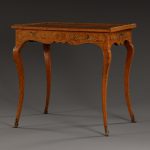

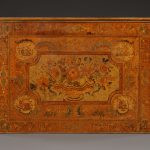


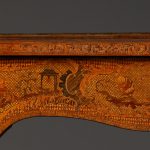
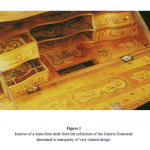
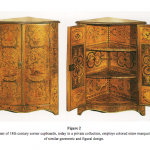
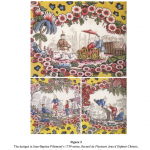
Comments are closed.